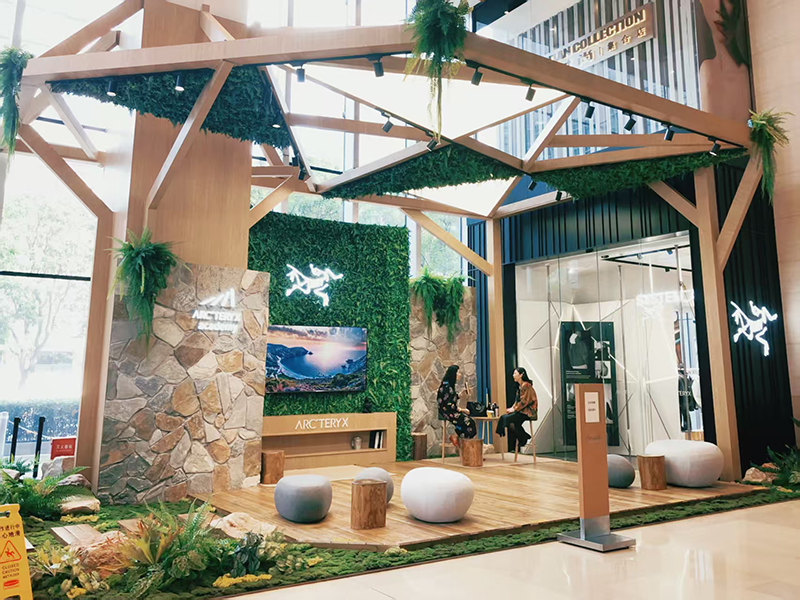In urban environments where space is at a premium, 3D artificial vertical gardens have emerged as a transformative solution, blending ecological benefits with architectural aesthetics. These living installations not only enhance biodiversity but also serve as dynamic design elements that adapt to diverse architectural styles. Below, we explore how vertical gardens can be seamlessly integrated with traditional and contemporary architectural forms, creating spaces that are both functional and visually striking.
Classical architecture, characterized by symmetry, proportion, and ornamental detail, often features grand facades and structured layouts. Vertical gardens can complement these traits by adding organic textures and vibrant colors to otherwise rigid surfaces. For instance, in Beijing-style architecture, where red walls and golden tiles dominate, a vertical garden could incorporate climbing plants with red or golden foliage, mirroring the palette of traditional palaces. Similarly, the geometric precision of classical columns and pediments can be echoed in the modular design of vertical garden panels, creating a dialogue between natural and man-made forms.
The integration also extends to functional aspects. In historic buildings, vertical gardens can act as thermal insulators, reducing cooling costs while preserving the structural integrity of aged facades. By using lightweight, self-supporting systems, designers can avoid invasive installations, ensuring that the garden enhances rather than detracts from the architectural heritage.
Modernist architecture emphasizes simplicity, functionality, and the use of industrial materials. Vertical gardens align with these principles by introducing natural elements in a controlled, minimalist manner. For example, in buildings with sleek glass facades, a vertical garden can serve as a "living curtain," softening the hard edges of the structure while providing privacy and shading. The use of drought-resistant succulents or air plants in modular frames can create a textured, monochromatic backdrop that complements the building’s clean lines.
In minimalist designs, vertical gardens can also act as focal points. A single wall covered in lush greenery can contrast with the surrounding neutral tones, drawing the eye and creating a sense of tranquility. This approach is particularly effective in urban settings, where vertical gardens can transform sterile concrete environments into oases of calm.
Projects like the Guangzhou Baiyun International Conference Center demonstrate how vertical gardens can bridge traditional and contemporary architectural languages. Located at the foot of Baiyun Mountain, the center’s landscape design incorporates vertical elements that mimic the natural contours of the surrounding hills. By using local plant species and traditional water features, the garden pays homage to Lingnan cultural heritage while employing modern irrigation and structural technologies.
This fusion is also evident in the garden’s spatial organization. The vertical gardens are strategically placed to frame views of the mountain, creating a visual dialogue between the built environment and nature. Similarly, in residential projects, vertical gardens can be designed to reflect regional architectural traditions, such as the courtyard layouts of Chinese siheyuan or the open-air verandas of Mediterranean villas.
The integration of vertical gardens with architectural styles is not merely aesthetic—it is also a response to environmental challenges. Modern vertical gardens often incorporate smart technologies, such as automated irrigation systems and solar-powered lighting, which reduce maintenance costs and energy consumption. These innovations align with the principles of sustainable design, making vertical gardens a viable solution for green building certifications like LEED or BREEAM.
In addition, vertical gardens can improve air quality, reduce urban heat island effects, and provide habitats for wildlife. By selecting plant species that are native to the region, designers can ensure that the gardens are low-maintenance and resilient to local climate conditions. This ecological approach enhances the building’s sustainability credentials while creating healthier, more livable spaces for occupants.
The fusion of 3D artificial vertical gardens with architectural styles represents a new frontier in sustainable design. By adapting to the unique characteristics of classical, modernist, and culturally specific forms, vertical gardens can transform buildings into living, breathing entities. Whether through color, texture, or function, these installations offer a way to reconnect with nature in urban environments, proving that beauty and ecology need not be mutually exclusive. As cities continue to grow, the integration of vertical gardens with architecture will become increasingly vital, offering a path toward greener, more harmonious urban landscapes.

Contact: Amy
Phone: 86-15311787313
E-mail: info@foszmac.com
Whatsapp:86-15311787313
Add: Fengtai District, Dacheng Road, No.24 Building, Room 203, Beijing, China